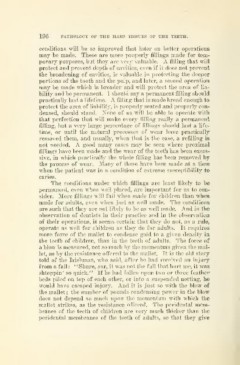Page 432 - My FlipBook
P. 432
196 PATHOLOGY OF THE HAED TISSUES OF THE TEETH.
conditions will be so improved that later on better operations
may be made. These are more properly fillings made for tem-
porary purposes, but they are very valuable. A filling that will
protect and prevent depth of cavities, even if it does not prevent
the broadening of cavities, is valuable in protecting the deeper
portions of the tooth and the pulp, and later, a second operation
may be made which is broader and will protect the area of lia-
bility and be permanent. I should say a permanent filling should
practically last a lifetime. A filling that is made broad enough to
protect the area of liabilitj^ is properly seated and properly con-
densed, should stand. None of us will be able to operate with
that perfection that will make every filling really a permanent
filling, but a very large percentage of fillings should last a life-
time, or until the natural processes of wear have practically
removed them, and usually, when that is the case, a refilling is
not needed. A good many cases may be seen where proximal
fillings have been made and the wear of the teeth has been exces-
sive, in which practically the whole filling has been removed by
the process of wear. Many of these have been made at a time
when the patient was in a condition of extreme susceptibility to
caries.
The conditions under which fillings are least likely to be
permanent, even when well placed, are important for us to con-
sider. More fillings will fail when made for children than when
made for adults, even when just as well made. The conditions
are such that they are not likely to be as well made. And in the
observation of dentists in their practice and in the observation
of their operations, it seems certain that they do not, as a rule,
operate as well for children as they do for adults. It requires
more force of the mallet to condense gold to a given density in
the teeth of children, than in the teeth of adults. The force of
a blow is measured, not so much by the momentum given the mal-
let, as by the resistance offered to the mallet. It is the old story
told of the Irishman, who said, after he had i"eceived an injury
from a fall : "Shure, sur, it was not the fall that hurt me, it was
shtoppin' so quick." If he had fallen upon two or three feather
beds piled on top of each other, or into a suspended netting, he
would have escaped injury. And it is just so with the blow of
the mallet ; the number of pounds condensing power in the blow
does not depend so much upon the momentum with which the
mallet strikes, as the resistance offered. The peridental mem-
branes of the teeth of children are very much thicker than the
peridental membranes of the teeth of adults, so that they give


